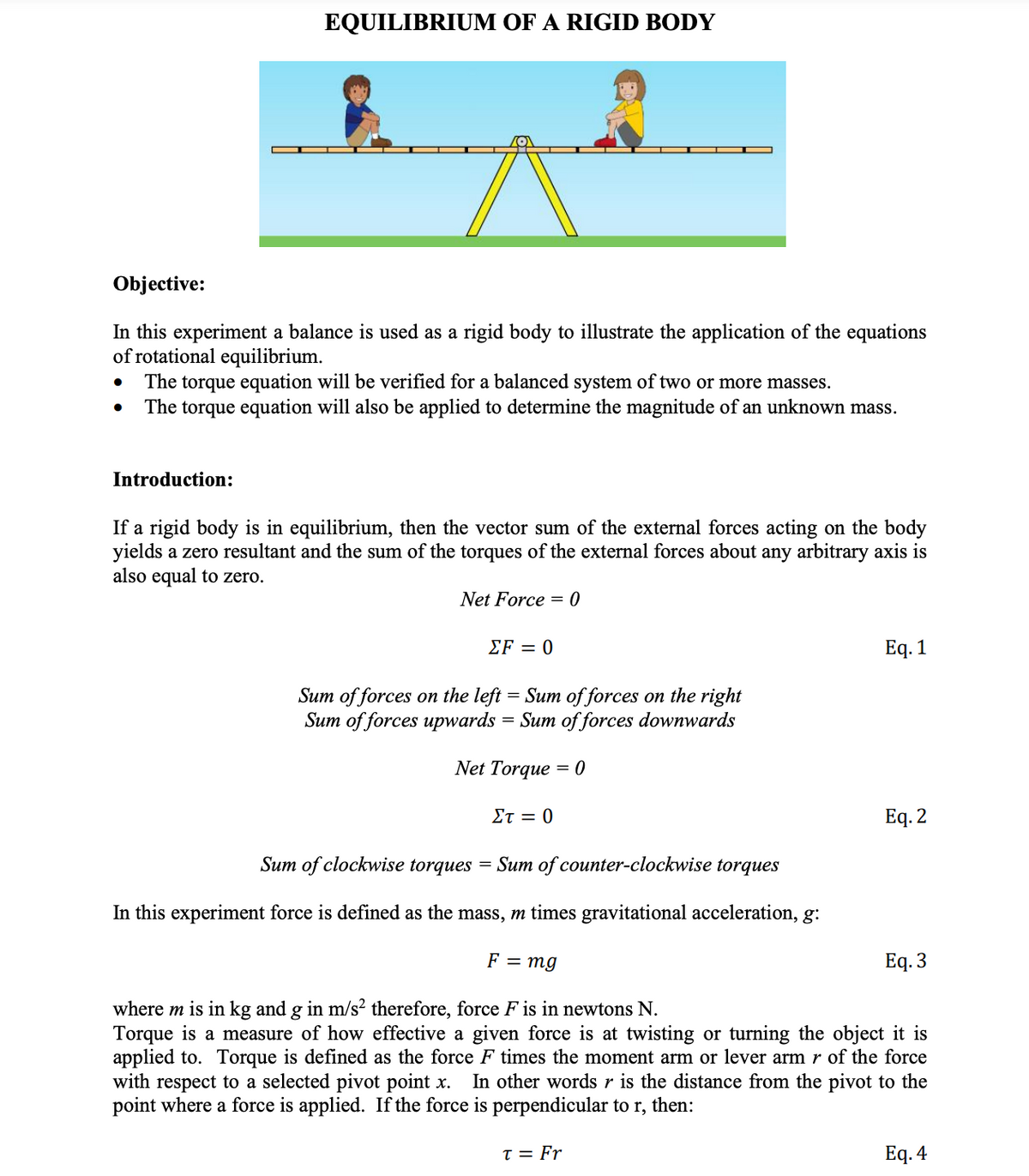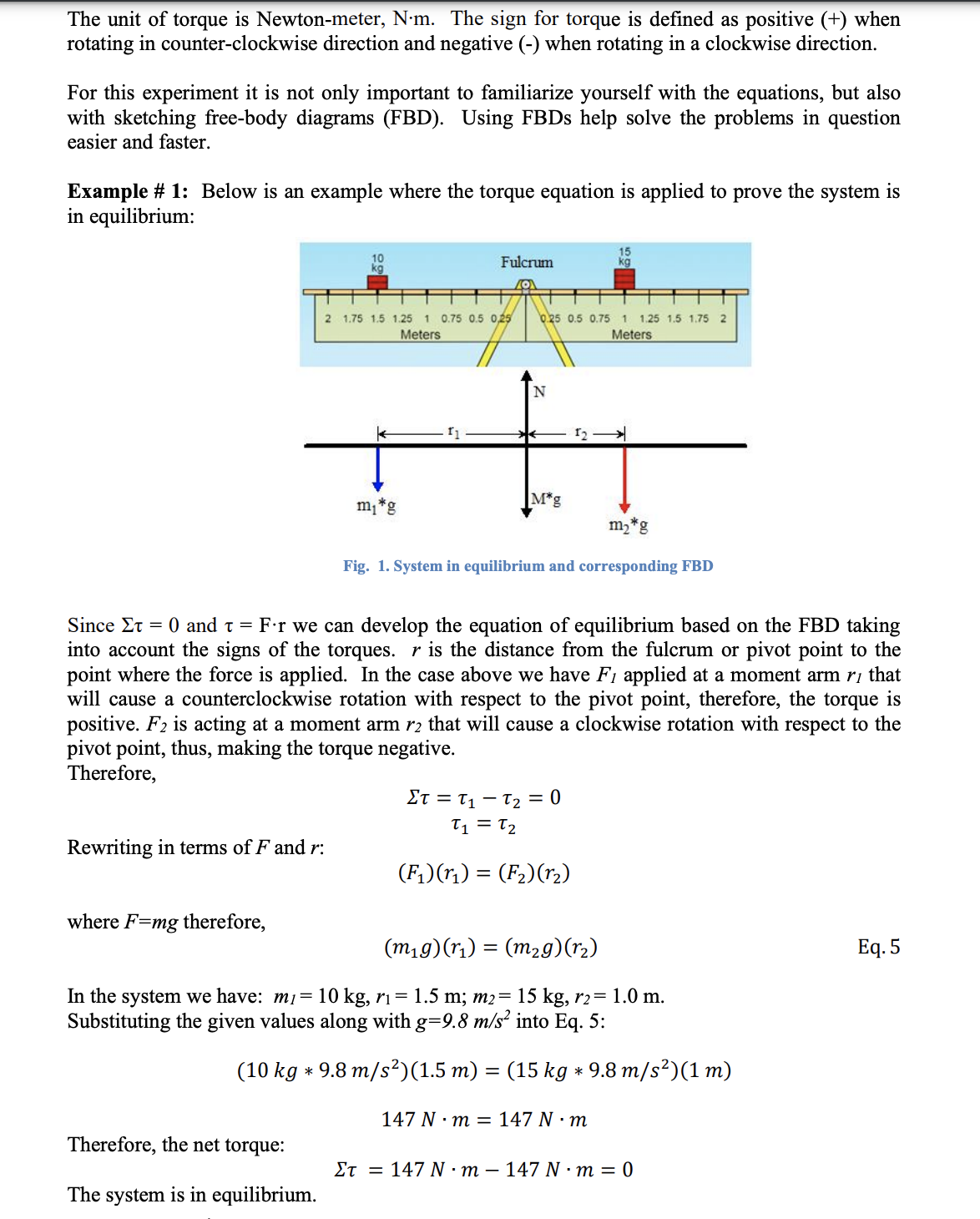Physics for Scientists and Engineers: Foundations and Connections
1st Edition
ISBN:9781133939146
Author:Katz, Debora M.
Publisher:Katz, Debora M.
Chapter13: Rotation Ii: A Conservation Approach
Section: Chapter Questions
Problem 6PQ: Rotational Inertia Problems 5 and 6 are paired. 5. N A system consists of four boxes modeled as...
Related questions
Question
What role does the mass play in balancing the see-saw? (Hint: Would you need to balance the rigid body in a “weightless” environment?)

Transcribed Image Text:EQUILIBRIUM OF A RIGID BODY
Objective:
In this experiment a balance is used as a rigid body to illustrate the application of the equations
of rotational equilibrium.
The torque equation will be verified for a balanced system of two or more masses.
The torque equation will also be applied to determine the magnitude of an unknown mass.
Introduction:
If a rigid body is in equilibrium, then the vector sum of the external forces acting on the body
yields a zero resultant and the sum of the torques of the external forces about any arbitrary axis is
also equal to zero.
Net Force = 0
ΣF0
Eq. 1
Sum of forces on the left = Sum of forces on the right
Sum of forces upwards = Sum of forces downwards
Net Torque = 0
Στ0
Еq. 2
Sum of clockwise torques
= Sum of counter-clockwise torques
In this experiment force is defined as the mass, m times gravitational acceleration, g:
F = mg
Eq. 3
where m is in kg and g in m/s² therefore, force F is in newtons N.
Torque is a measure of how effective a given force is at twisting or turning the object it is
applied to. Torque is defined as the force F times the moment arm or lever arm r of the force
with respect to a selected pivot point x. In other words r is the distance from the pivot to the
point where a force is applied. If the force is perpendicular to r, then:
T = Fr
Eq. 4

Transcribed Image Text:The unit of torque is Newton-meter, N-m. The sign for torque is defined as positive (+) when
rotating in counter-clockwise direction and negative (-) when rotating in a clockwise direction.
For this experiment it is not only important to familiarize yourself with the equations, but also
with sketching free-body diagrams (FBD). Using FBDS help solve the problems in question
easier and faster.
Example # 1: Below is an example where the torque equation is applied to prove the system is
in equilibrium:
Fulcrum
2 1.75 1.5 1.25 1 0.75 0.5 0,25
Meters
0.25 0.5 0.75 1 1.25 1.5 1.75 2
Meters
m,*g
M*g
m,*g
Fig. 1. System in equilibrium and corresponding FBD
Since Et
= 0 and t = F:r we can develop the equation of equilibrium based on the FBD taking
into account the signs of the torques. r is the distance from the fulcrum or pivot point to the
point where the force is applied. In the case above we have F1 applied at a moment arm rị that
will cause a counterclockwise rotation with respect to the pivot point, therefore, the torque is
positive. F2 is acting at a moment arm r2 that will cause a clockwise rotation with respect to the
pivot point, thus, making the torque negative.
Therefore,
Et = T, – T, = 0
T1 = T2
Rewriting in terms of F and r:
(F,)(ri) = (F2)(r2)
where F=mg therefore,
(m1 9)(ri) = (m2g)(r2)
Еq. 5
In the system we have: m1= 10 kg, rı= 1.5 m; m2= 15 kg, r2= 1.0 m.
Substituting the given values along with g=9.8 m/s² into Eq. 5:
(10 kg * 9.8 m/s²)(1.5 m) = (15 kg * 9.8 m/s²)(1 m)
147 N :т %3 147 N :т
Therefore, the net torque:
Et = 147 N ·m – 147 N ·m = 0
The system is in equilibrium.
Expert Solution
This question has been solved!
Explore an expertly crafted, step-by-step solution for a thorough understanding of key concepts.
This is a popular solution!
Trending now
This is a popular solution!
Step by step
Solved in 2 steps

Knowledge Booster
Learn more about
Need a deep-dive on the concept behind this application? Look no further. Learn more about this topic, physics and related others by exploring similar questions and additional content below.Recommended textbooks for you

Physics for Scientists and Engineers: Foundations…
Physics
ISBN:
9781133939146
Author:
Katz, Debora M.
Publisher:
Cengage Learning

Glencoe Physics: Principles and Problems, Student…
Physics
ISBN:
9780078807213
Author:
Paul W. Zitzewitz
Publisher:
Glencoe/McGraw-Hill

Physics for Scientists and Engineers, Technology …
Physics
ISBN:
9781305116399
Author:
Raymond A. Serway, John W. Jewett
Publisher:
Cengage Learning

Physics for Scientists and Engineers: Foundations…
Physics
ISBN:
9781133939146
Author:
Katz, Debora M.
Publisher:
Cengage Learning

Glencoe Physics: Principles and Problems, Student…
Physics
ISBN:
9780078807213
Author:
Paul W. Zitzewitz
Publisher:
Glencoe/McGraw-Hill

Physics for Scientists and Engineers, Technology …
Physics
ISBN:
9781305116399
Author:
Raymond A. Serway, John W. Jewett
Publisher:
Cengage Learning

Principles of Physics: A Calculus-Based Text
Physics
ISBN:
9781133104261
Author:
Raymond A. Serway, John W. Jewett
Publisher:
Cengage Learning

College Physics
Physics
ISBN:
9781305952300
Author:
Raymond A. Serway, Chris Vuille
Publisher:
Cengage Learning

College Physics
Physics
ISBN:
9781285737027
Author:
Raymond A. Serway, Chris Vuille
Publisher:
Cengage Learning